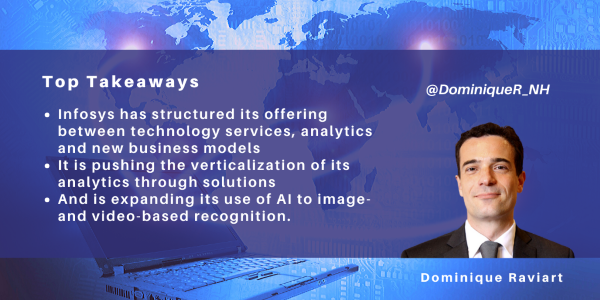Search posts by keywords:
Filter posts by author:
Related Reports
Related NEAT Reports
Other blog posts
posted on Nov 11, 2019 by Dominique Raviart

We recently talked to Infosys about its analytics and big data capabilities in its Data and Analytics (DNA) practice.
DNA is a significant practice within Infosys, which we estimate represents ~8% of Infosys’ headcount. It continues to enhance its portfolio, expanding from technical services to business services, and segments its portfolio around three themes: Modernize, Monetize, and Network.
Shifting the portfolio from technology services to new business models
Modernize offerings cover the IT side of analytics and big data, with most activities centering around big data, data lakes EDW and cloud (for both cloud hosting and PaaS), taking a brownfield approach and making use of existing client investments. DNA highlights that client demand is driven by use cases.
Under the Monetize umbrella, DNA is using analytics to help clients improve operations to grow revenues, drive operation efficiency and meet GDPR compliance. Most Monetize projects are based on more widespread use of analytics.
With its Network offerings, DNA supports clients in launching new services based on data, from both internal and external sources.
As part of this portfolio, DNA has launched its Infosys Data Marketplace (IDM) IP and services and is helping a medical device firm develop new health services using IoT-based data such as nutritional and fitness data.
With IDM, DNA highlights that it wants to democratize business models based on data.
Continued push in portfolio verticalization
In parallel, DNA continues to specialize its services and has structured its specialization effort around two areas: verticalization in the form of solutions & blueprints and AI.
Verticalization continues to be a priority, with DNA having created multiple software-based solutions for the different sectors it covers. DNA drives its verticalization effort with Infosys’ vertical units and produces either standalone accelerators or solutions (e.g. inventory optimization, supply chain early warnings) or embeds analytics within a larger Infosys platform (e.g. within the Finacle Universal Banking Solution).
A recent example of a standalone analytics solution is its Healthcare Analytics Platform, targeting the needs of service providers and bringing analytics to hospitals around members – e.g. in the field of precision medicine, disease analysis and utilization rates.
Investing in AI use cases
AI continues to be a significant driving force behind Infosys overall and DNA in particular.
An example of recent investment is Digital Brain for its HR needs, to match the needs of projects for specific skill profiles and identifying corresponding employees, along with selecting training sessions to help Infosys’ personnel to acquire digital skills, specifically for upcoming projects.
Infosys has positioned Digital Brain as part of its Live Enterprise initiative and is one of the cornerstones of how Infosys is becoming a digital enterprise.
In parallel, DNA is systematically mapping uses for AI. A core element of DNA’s AI portfolio addresses uses cases such as fraud management, product recommendation engines, and chatbots. Increasingly, DNA has worked with clients on image- and video-based recognition and has developed accelerators that include driver drowsiness detection (automotive), damage detection (insurance), and queue counter/customer wait line (retail).
To favor the spreading of AI across clients, DNA is pushing the notion of AI pods with the intent of making its clients more aware of AI possibilities. The company has structured AI pods in several forms, whether client-dedicated or working for several clients, and focused on AI technologies such as video analytics or specific use cases.
Analytics becoming more business-oriented
Looking ahead, outside of the IT department, clients are asking for further analytics across their operations, pushing their IT function to democratize analytics tools. Next-gen dashboards such as data visualization tools are helping here but are only the beginning of the answer. We expect vendors will further invest in this area with more vertically-aligned and non-technical user-friendly dashboards.
IT departments are still facing challenges of complex technologies and data migration to data lakes and big data infrastructures. Vendors are reducing this complexity by building platforms to collect and clean data and run analytics. Their next challenge is around AI: AI brings a new level of complexity that is further constrained by the small number of AI specialists globally. We are starting to see vendors investing in making the creation of AI-based algorithms more accessible to non-specialists.
Expect DNA to invest more in making big data and AI technology usage more accessible to non-specialists, while continuing to work with their business groups to make analytics more relevant to business needs.
